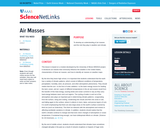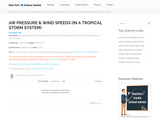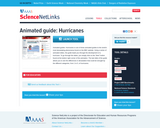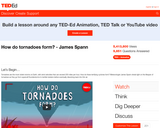
Students learn about air masses and the role they play in weather and climate.
- Subject:
- Earth Science
- Science
- Material Type:
- Lesson Plan
- Provider:
- American Association for the Advancement of Science
- Author:
- AAAS
- Date Added:
- 02/26/2019

Students learn about air masses and the role they play in weather and climate.

Students will graph data to better understand the relationship of low pressure to storm severity.

This interactive resource uses a series of animated slides to guide students through the development of a hurricane.

This experiment from Bill Nye explains how to make a tornado in a bottle. Students will learn how gravity and air mass work together when creating a tornado contained within 2 bottles. Students will also discover how wind speed increases when colliding with warm air to create real world disasters that are known to be much more intense than hurricanes.

Students will read a scientific article related to global climate change and hurricanes and write a summary of the article.

Students study the storms that ravaged the southeastern region of the U.S. and the Caribbean and investigate connections between climate change and extreme weather events.

In this activity students will learn about air masses, fronts, pressure systems, and wind patterns in relation to regional weather.

In this tutorial students will investigate different types of weather phenomena (lightning, tornadoes, hurricanes, blizzards and floods). Students will also relate unequal heating of land and water surfaces to form large global wind systems and weather events such as tornados and thunderstorms

Students manipulate virtual variables such as wind strength and direction, latitudinal location, atmospheric moisture, and sea temperature to create ideal conditions for hurricane formation in this interactive activity.

In this unit students will learn about specific dangers of storms and hurricane hazards. Students will also look at safety precautions.

In this unit students will learn about specific dangers of storms and hurricane hazards. Students will also look at safety precautions.

In this unit students will learn about specific dangers of storms and hurricane hazards. Students will also look at safety precautions.

In this activity students will watch a video and learn where hurricanes form. Students will also learn how hurricanes form.

Hurricanes move in generally predictable patterns. This part of the investigation focuses on these patterns for hurricanes in the Atlantic Ocean. First you'll examine the movie again to see if you can identify the patterns empirically. Then you will try to tie your observations together with information about global wind patterns.

In this lesson, students examine global climate model output available online and consider the potential impact of global warming on tropical cyclone initiation and evolution. As a follow-up, students read two short articles on the connection between hurricanes and global warming and discuss these articles in context of what they have learned from model output.

This activity allows students to track hurricane data using coordinates.

This brief video lesson discusses the weather conditions that foster tornado formation. Discussion/assessment questions and suggested supplemental resources are also included.

This brief video lesson discusses the weather conditions that foster tsunami formation. Discussion/assessment questions and suggested supplemental resources are also included.

In this investigation, students will look at a number of videos, animations, and images in order to gain a better understanding of how hurricanes work. In the first part, students will learn about some of the satellites that researchers use to study and make forecasts about hurricanes. Then students will get a chance to look "under the hood" of a hurricane to see how these storms develop.

In this activity students will learn about advances in computer models and observational methods which have made it possible to learn more about how hurricanes develop.